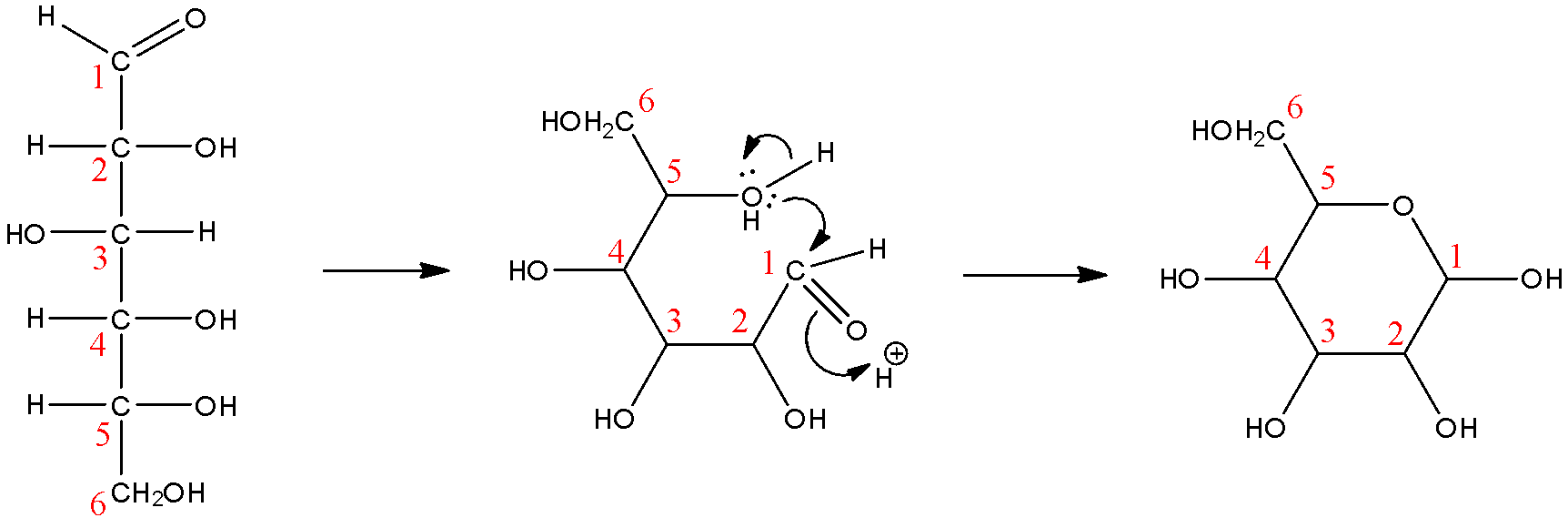
Why is glucose called gluco-pyranose?
A. Glucose is an aldohexose
B. Glucose is a cyclic compound containing five carbon atoms and one oxygen atom
C. Glucose is ketohexose
D. Glucose is a cyclic compound containing six carbon atoms.
Answer
141.3k+ views
Hint: Think about the process of cyclization of glucose and what kind of ring is formed. Also, consider what exactly it means to be a pyranose molecule and what types of rings it includes.
Complete step by step solution:
First, we need to understand that although we may see that glucose is often represented as an open-chain molecule, that may not always be the case. The ring form or the cyclized form of glucose is found abundantly and chiefly in nature. Glucose is a six-carbon molecule with an aldehyde functional group, it is due to the intramolecular attraction between the hydroxyl groups on the carbons and the oxygen in the aldehyde functional group that these linear molecules cyclize into rings.
Now let us look at the cyclization reaction:

Here, we can see that while the ring form of glucose does have 6 carbon atoms, only 5 of them are involved in the cyclic ring. We will now see how the pyranose rings are defined before arriving at our answer. Pyranose rings are a defined class of saccharides that are six-membered rings that contain 5 carbon atoms and 1 oxygen atom. We can see that this is true in the reaction.
So, we can conclude that the correct answer to this question is ‘B. Glucose is a cyclic compound containing five carbon atoms and one oxygen atom’
Note: Note that the options ‘A’ and ‘D’ are also true but they are not the right answer to this question. Let us consider option A first, glucose is an aldehydic sugar that contains 6 atoms of carbon, but this fact does not explain why glucose will be called gluco-pyranose, so this is not the correct answer. Now, let us consider option D, gluco-pyranose is a cyclic compound, it does contain 6 carbon atoms, but the oxygen atom that has to be present in pyranose rings is not mentioned here at all, it also indicates that all the 6 carbons are involved in the ring, which is not true, so this is not the correct answer either.
Complete step by step solution:
First, we need to understand that although we may see that glucose is often represented as an open-chain molecule, that may not always be the case. The ring form or the cyclized form of glucose is found abundantly and chiefly in nature. Glucose is a six-carbon molecule with an aldehyde functional group, it is due to the intramolecular attraction between the hydroxyl groups on the carbons and the oxygen in the aldehyde functional group that these linear molecules cyclize into rings.
Now let us look at the cyclization reaction:

Here, we can see that while the ring form of glucose does have 6 carbon atoms, only 5 of them are involved in the cyclic ring. We will now see how the pyranose rings are defined before arriving at our answer. Pyranose rings are a defined class of saccharides that are six-membered rings that contain 5 carbon atoms and 1 oxygen atom. We can see that this is true in the reaction.
So, we can conclude that the correct answer to this question is ‘B. Glucose is a cyclic compound containing five carbon atoms and one oxygen atom’
Note: Note that the options ‘A’ and ‘D’ are also true but they are not the right answer to this question. Let us consider option A first, glucose is an aldehydic sugar that contains 6 atoms of carbon, but this fact does not explain why glucose will be called gluco-pyranose, so this is not the correct answer. Now, let us consider option D, gluco-pyranose is a cyclic compound, it does contain 6 carbon atoms, but the oxygen atom that has to be present in pyranose rings is not mentioned here at all, it also indicates that all the 6 carbons are involved in the ring, which is not true, so this is not the correct answer either.
Recently Updated Pages
Classification of Drugs Based on Pharmacological Effect, Drug Action

Difference Between Alcohol and Phenol

JEE Main Participating Colleges 2024 - A Complete List of Top Colleges

JEE Main Maths Paper Pattern 2025 – Marking, Sections & Tips

Sign up for JEE Main 2025 Live Classes - Vedantu

JEE Main 2025 Helpline Numbers - Center Contact, Phone Number, Address

Trending doubts
JEE Main 2025 Session 2: Application Form (Out), Exam Dates (Released), Eligibility, & More

JEE Main Exam Marking Scheme: Detailed Breakdown of Marks and Negative Marking

JEE Main 2025: Derivation of Equation of Trajectory in Physics

Electric Field Due to Uniformly Charged Ring for JEE Main 2025 - Formula and Derivation

Types of Solutions

Learn About Angle Of Deviation In Prism: JEE Main Physics 2025

Other Pages
NCERT Solutions for Class 12 Chemistry Chapter 6 Haloalkanes and Haloarenes

NCERT Solutions for Class 12 Chemistry Chapter 2 Electrochemistry

NCERT Solutions for Class 12 Chemistry Chapter 7 Alcohol Phenol and Ether

NCERT Solutions for Class 12 Chemistry Chapter 1 Solutions

Solutions Class 12 Notes: CBSE Chemistry Chapter 1

Electrochemistry Class 12 Notes: CBSE Chemistry Chapter 2




